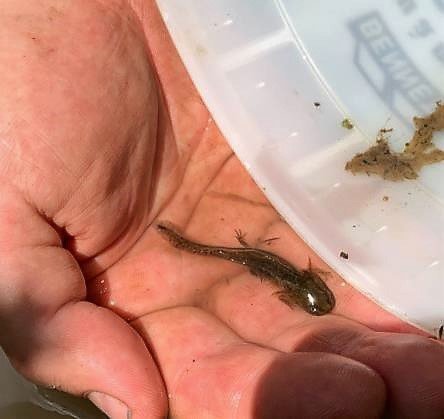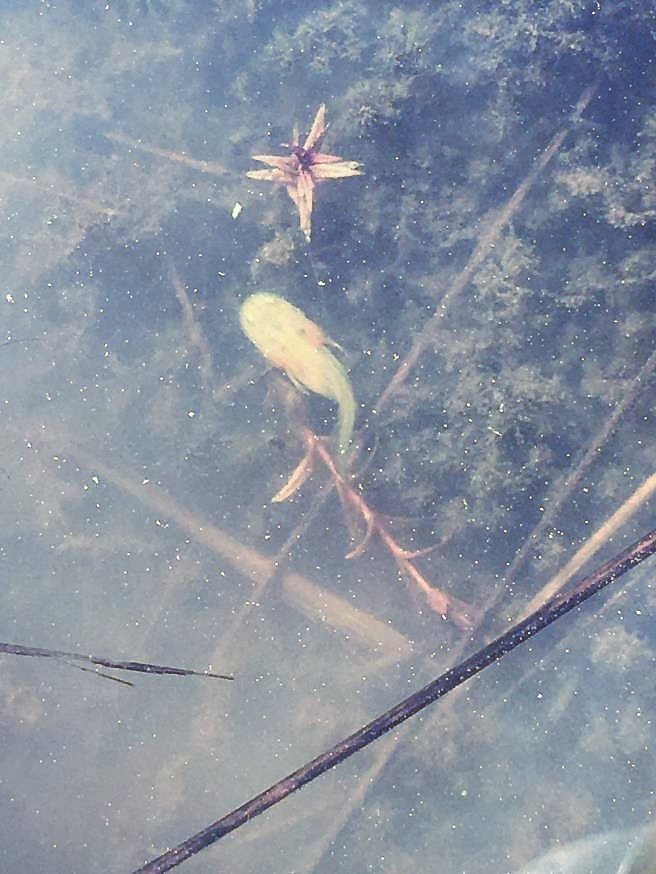Species Spotlight: Long-toed Salamander
Long-toed Salamander
Long-toed Salamander (Ambystoma macrodactylum)
Under the cover of darkness, a small, sleek amphibian emerges from beneath ground cover. Part of the mole salamander family, the long-toed salamander (Ambystoma macrodactylum) is mostly nocturnal and spends much of its time hidden under rocks and woody debris in boreal habitats and montane basins.
The species is named from the extra-long fourth toe they sport on their rear feet. Long-toed salamanders are mottled black and brown in color with yellow, tan, or olive-green coloration down their backs. The species is made up of 5 subspecies and can be found from northern California all the way into Alberta and British Columbia. They are one of the most widely distributed salamanders in North America, second only to the tiger salamander.
Reproduction & Habitat
Salamander eggs covered by sediment observed by an AJM Environmental Scientist.
Like other amphibians, long-toed salamanders breed in the spring. However, since they can be found at higher elevations, adults may even gather to lay eggs in pools before the winter ice has melted. They attach their eggs, either singly or in small clusters, to submerged rocks or vegetation in ponds and puddles that do not have any fish.
The eggs have doubled protection, with two layers of jelly, whereas frogs and toads have only one layer. After a few weeks, the eggs hatch to reveal small larval salamanders that can breathe underwater using their frilly gills. The larvae shed their gills at the end of the summer and emerge onto land to head upland into their adult habitats. However, particularly at higher elevations, this species may stay in its larval form for more than one season before emerging onto land. Once they emerge from their breeding wetlands, it may take 2-3 years for the salamanders to reach sexual maturity, and they may not breed every year. The long-toed salamander’s average lifespan is 6-7 years, but they may even live as long as 10 years of age.
ong-toed salamanders are philopatric, meaning they return to the same breeding and overwintering sites year after year. Their home ranges are relatively small, but they have been found to travel as far as 900 metres from their breeding ponds. Due to their high reliance on the same habitat year after year, their necessity for non-fish bearing breeding wetlands, and their delicate physical nature, they are classified as Species of Special Concern in Alberta.
Long-toed salamander metamorphic larva found in a pool by an AJM Environmental Scientist.
Threats
In many ways, the conservation of this species is closely tied to human activity. The stocking of ponds with game fish to support recreational fishing in long-toed salamander habitat, may pose a threat to the ability of this species to reproduce and emerge from breeding wetlands. Additionally, human recreation in salamander habitat in the spring, including ATV use, hiking, dog walking, and horseback riding, threatens salamander eggs and larvae where they exist in shallow pools and puddles in and around trails and popular recreational areas.
Human degradation of wetland habitat is also a threat to this species. Draining wetlands without the restoration of existing hydrology may eliminate breeding pools for local populations. Reductions in the water quality of breeding wetlands impacts the development of eggs and larvae. Poor water quality also threatens the survival of all salamander life stages, due to their permeable skin and sensitive nature. In terrestrial habitats, removing vegetation cover, rocks, and coarse woody debris can dry the landscape and remove suitable damp habitat for this species. The creation of human infrastructure can create movement barriers that deny the salamanders access to their critical habitat, or require them to cross roads, which exposes them to an increased risk of death or injury.
Risk Management & Mitigation
A wetland where long-toed salamanders were salvaged from by AJM Environmental Scientists due to nearby construction activites.
Despite the threats, there are many ways to manage and mitigate risks for this species. Resource specialists, like those at AJM, have experience working with provincial species management best practices to help guide recreational and industrial projects that may affect sensitive species, including the long-toed salamander. In the provinces of British Columbia, Alberta, and Saskatchewan, the provincial Wildlife Act protects wildlife from impacts that might result from human activities, including construction projects. Proponents are required to implement effective measures to avoid or mitigate impacts. Site isolation and/or amphibian salvage and relocation are examples of avoidance/mitigation measures used for projects where detrimental effects to amphibian species may occur.
A wetland where long-toed salamanders were salvaged from by AJM Environmental Scientists due to nearby construction activites.
Despite the threats, there are many ways to manage and mitigate risks for this species. Resource specialists, like those at AJM, have experience working with provincial species management best practices to help guide recreational and industrial projects that may affect sensitive species, including the long-toed salamander. In the provinces of British Columbia, Alberta, and Saskatchewan, the provincial Wildlife Act protects wildlife from impacts that might result from human activities, including construction projects. Proponents are required to implement effective measures to avoid or mitigate impacts. Site isolation and/or amphibian salvage and relocation are examples of avoidance/mitigation measures used for projects where detrimental effects to amphibian species may occur.
A wetland where long-toed salamanders were relocated to by AJM Environmental Scientists.
AJM has and continues to support construction activities that occur within known amphibian ranges or in proximity to amphibian habitat.
Our support to these projects consists of the planning and/or application of appropriate environmental mitigations, including the implementation of barriers to project sites, and salvage and relocation of amphibians away from project activities. This past summer alone, the AJM field crews helped protect thousands of salamanders, as well as frogs and toads, by relocating them out of harms way during pipeline construction!
An effective amphibian mitigation and salvage plan will:
A relocated salamander larva after being released into a wetland by an AJM Environmental Scientist.
Assess project specific impacts by determining the scope of project activities and identifying where they may intersect with and impact amphibians and amphibian habitat,
Detail methods for field-based amphibian species detection, and the identification of all life stages,
Inform how to effectively and safely mitigate impacts anticipated to occur in or near the project’s footprint,
Guide crew members on how and when to communicate relevant observations to other responsible on-site personnel (e.g., Environmental Inspector [EI]),
Advise on how construction or its sequencing could be altered to limit (or eliminate the potential for) harm to the amphibian species/habitat in focus, and
Detail the methods for salvage and relocation of amphibian species that need to be removed from the project site.
Long-toed salamander larva
For more information on how to safely manage the risks on your projects to Species of Special Concern, such as the long-toed salamander, connect with an AJM crew member today!
By: Miriam Boucher MSc., P.Biol., R.P.Bio.







